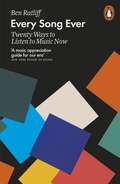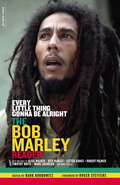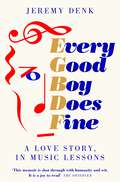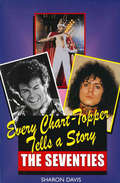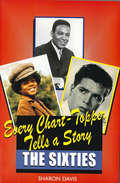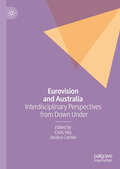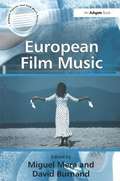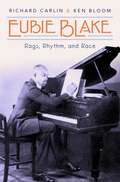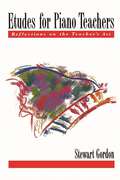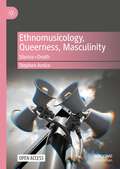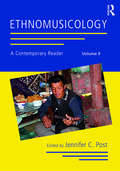- Table View
- List View
'Every Sound There Is': The Beatles' Revolver and the Transformation of Rock and Roll
by Russell Reising'Every Sound There Is': Revolver and the Transformation of Rock and Roll assesses and celebrates the Beatles' accomplishment in their 1966 masterpiece. The essays of Every Sound There Is examine Revolver from a large number of complementary starting points that help us to understand both the album's contemporary creation and reception and the ways in which it continues to shape the creation and reception of popular music in the twenty-first century. Responding to the incredible diversity of Revolver, this gathering of international scholars focuses on the Beatles' 1966 album as one of rock and roll history's threshold moments. Bringing to bear approaches from the disciplines of musicology, cultural studies, poetics, gender studies, these essays address matters as diverse as the influence of American R&B on Revolver as well as its influence on Pink Floyd, each Beatle‘s contributions to the album, the musicological significance of the Beatles' harmonies and chord progressions, its status and coherence as a work of art, the technological and marketing significance of Revolver's recording and distribution, and its influence on the development of rock music.
'Every Sound There Is': The Beatles' Revolver and the Transformation of Rock and Roll
by Russell Reising'Every Sound There Is': Revolver and the Transformation of Rock and Roll assesses and celebrates the Beatles' accomplishment in their 1966 masterpiece. The essays of Every Sound There Is examine Revolver from a large number of complementary starting points that help us to understand both the album's contemporary creation and reception and the ways in which it continues to shape the creation and reception of popular music in the twenty-first century. Responding to the incredible diversity of Revolver, this gathering of international scholars focuses on the Beatles' 1966 album as one of rock and roll history's threshold moments. Bringing to bear approaches from the disciplines of musicology, cultural studies, poetics, gender studies, these essays address matters as diverse as the influence of American R&B on Revolver as well as its influence on Pink Floyd, each Beatle‘s contributions to the album, the musicological significance of the Beatles' harmonies and chord progressions, its status and coherence as a work of art, the technological and marketing significance of Revolver's recording and distribution, and its influence on the development of rock music.
Every Song Ever: Twenty Ways to Listen to Music Now
by Ben RatliffFrom one of America's celebrated critics, the definitive field guide to listening to music in the age of the CloudThe most significant revolution in the recent history of music has to do with listening: it is now possible to listen to nearly anything at any time, to ignore albums, and to instantly flit across genres and generations, from 1980s Detroit techno to 1890s Viennese neo-romanticism. Yet music criticism has historically focused on the musician's intent, not the listener's experience. Every Song Ever is therefore the definitive field guide to listening in an age of glorious, overwhelming abundance. By revealing the essential similarities between wildly different kinds of music, Ben Ratliff shows how we listen to music now, and suggests how we can listen better.
Every Little Thing Gonna Be Alright: The Bob Marley Reader
by Hank BordowitzThroughout Africa, the Caribbean, Europe, and America, Bob Marley represents far more than just the musician who translated spiritual and political beliefs into hypnotic, hard-hitting songs such as "Get Up, Stand Up," "No Woman, No Cry," and "Jammin'." Marley was born in rural Jamaica and reared in the mean streets of Kingston's Trenchtown; his ascent to worldwide acclaim, first with The Wailers--Peter Tosh and Bunny Livingstone--and later as a solo artist, is a riveting story of the spiritual awakening of a uniquely talented individual.Now, for the first time, a symphony of voices has joined together to offer perspective on one of this century's most compelling figures. Dealing with Bob Marley as a man and myth, from his "rude boy" teens to international fame and his tragic death at the age of thirty-six, Every Little Thing Gonna Be Alright then explores the larger picture, examining Marley as the spokesman for Jamaica's homegrown religion of Rastafarianism, as a flash point for the pressure cooker of Jamaican politics, and his unique status as the first pop musical superstar of the so-called "Third World."
Every Little Thing Gonna Be Alright: The Bob Marley Reader
by Hank BordowitzThroughout Africa, the Caribbean, Europe, and America, Bob Marley represents far more than just the musician who translated spiritual and political beliefs into hypnotic, hard-hitting songs such as "Get Up, Stand Up," "No Woman, No Cry," and "Jammin'." Marley was born in rural Jamaica and reared in the mean streets of Kingston's Trenchtown; his ascent to worldwide acclaim, first with The Wailers--Peter Tosh and Bunny Livingstone--and later as a solo artist, is a riveting story of the spiritual awakening of a uniquely talented individual.Now, for the first time, a symphony of voices has joined together to offer perspective on one of this century's most compelling figures. Dealing with Bob Marley as a man and myth, from his "rude boy" teens to international fame and his tragic death at the age of thirty-six, Every Little Thing Gonna Be Alright then explores the larger picture, examining Marley as the spokesman for Jamaica's homegrown religion of Rastafarianism, as a flash point for the pressure cooker of Jamaican politics, and his unique status as the first pop musical superstar of the so-called "Third World."
Every Good Boy Does Fine: A Love Story, in Music Lessons
by Jeremy DenkA uniquely illuminating memoir of the making of a musician, in which renowned pianist Jeremy Denk explores what he learned from his teachers about classical music: its forms, its power, its meaning - and what it can teach us about ourselves.In this searching and funny memoir, based on his popular New Yorker article, renowned pianist Jeremy Denk traces an implausible journey. Life is difficult enough as a precocious, temperamental, and insufferable six-year-old piano prodigy in New Jersey. But then a family meltdown forces a move to New Mexico, far from classical music’s nerve centers, and he has to please a new taskmaster while navigating cacti, and the perils of junior high school. Escaping from New Mexico at last, he meets a bewildering cast of college music teachers, ranging from boring to profound, and experiences a series of humiliations and triumphs, to find his way as one of the world’s greatest living pianists, a MacArthur 'Genius,' and a frequent performer at Carnegie Hall.There are few writers working today who are willing to eloquently explore both the joys and miseries of artistic practice. Hours of daily repetition, mystifying early advice, pressure from parents and teachers who drove him on – an ongoing battle of talent against two enemies: boredom and insecurity. As we meet various teachers, with cruel and kind streaks, Denk composes a fraught love letter to the act of teaching. He brings you behind the scenes, to look at what motivates both student and teacher, locked in a complicated and psychologically perilous relationship.In Every Good Boy Does Fine, Denk explores how classical music is relevant to 'real life,' despite its distance in time. He dives into pieces and composers that have shaped him – Bach, Mozart, Schubert, and Brahms, among others – and gives unusual lessons on melody, harmony, and rhythm. Why and how do these fundamental elements have such a visceral effect on us? He tries to sum up many of the lessons he has received, to repay the debt of all his amazing teachers; to remind us that music is our creation, and that we need to keep asking questions about its purpose.
Every Chart Topper Tells a Story: The Seventies
by Sharon DavisThe seventies witnessed great changes not only in dress style but also in music. The psychedelia of the late sixties had mutated into glam rock by the early seventies, while the latter half of the decade is best remembered for the punk and disco explosions which gripped both Britain and America. The number-one singles of the decade are recalled in Every Chart Topper Tells a Story: The Seventies, from artists as diverse as Gary Glitter, David Bowie, Jimi Hendrix, Diana Ross, The Bee Gees, T-Rex, Commodores, Donny Osmond, The Three Degrees and Abba. It is the ideal volume both for those wanting a trip down memory lane and for serious music connoisseurs.
Every Chart Topper Tells a Story: The Sixties
by Sharon DavisThe glorious sixties were a decade for the young and rebellious, of cultural freedom and of sexual liberation. The British music scene had never been so adventurous, taking even the American charts by storm.Every Chart-Topper Tells a Story: The Sixties takes a look at the number-one hit singles of the decade in Britain from artists such as The Rolling Stones, The Beatles, Elvis Presley, Dusty Springfield, Ken Dodd, Cilla Black, The Supremes, Cliff Richard and Helen Shapiro, and is a valuable and entertaining source of information for all those interested in the sixties' music scene.
Ever Fallen in Love: The Lost Buzzcocks Tapes
by Pete Shelley Louie Shelley***'Lots of great stories... A fascinating insight.'-JOHN MAHER, Buzzcocks'Perfectly executed, highly detailed, incredibly interesting.'-HENRY ROLLINS, Black Flag'Pete and Buzzcocks were there right from the beginning.'-BERNARD SUMNER, Joy Division, New Order When Pete Shelley, lead singer of legendary punk band Buzzcocks, passed away in 2018 we lost the chance to hear one of music's brightest stars tell his story.Or so it seemed.Now, recordings have surfaced of a series of remarkable interviews in which Pete tells the story of his life, his band and his place at the beating heart of the punk explosion in fascinating detail.Recorded over a series of late-night calls with a close friend, the tapes hear Pete talk song-by-song through Buzzcocks releases to reveal the personal memories behind the music and the inspiration for masterpieces such as 'Ever Fallen in Love (With Someone You Shouldn't've)' and 'What Do I Get?'.Published for the first time and with the blessing of Pete's estate, Ever Fallen In Love: The Lost Buzzcocks Tapes is a tribute to a founding member of punk and a chance to hear one of music's true visionaries tell his own story at last.'A true gentleman and a great artist and songwriter.'-PETER HOOK, Joy Division, New Order 'Shot through with self-doubt and mild regret, Pete Shelley's lovesick pop classics have a bittersweet charm that will forever speak to the young romantic'-JOHN COOPER CLARKE'Buzzcocks were the blue touchpaper for my love of music. Pure pop met punk and the result was perfection.'-TIM BURGESS, The Charlatans
Evangelical Worship: An American Mosaic
by Melanie C. RossSay the words "evangelical worship" to anyone in the United States -- even if they are not particularly religious -- and a picture will likely spring to mind unbidden: a mass of white, middle-class worshippers with eyes closed, faces tilted upward, and hands raised to the sky. Yet despite the centrality of this image, many scholars have underestimated evangelical worship as little more than a manipulative effort to arouse devotional exhilaration. It is frequently dismissed as a reiteration of nineteenth-century revivalism or a derivative imitation of secular entertainment -- three Christian rock songs and a spiritual TED talk. But by failing to engage this worship seriously, we miss vital insights into a form of Protestantism that exerts widespread influence in the United States and around the world. Evangelical Worship offers a new way forward in the study of American evangelical Christianity. Weaving together insights from American religious history and liturgical studies, and drawing on extensive fieldwork in seven congregations, Melanie C. Ross brings contemporary evangelical worship to life. She argues that corporate worship is not a peripheral "extra" tacked on to a fully-formed spiritual, political, and cultural movement, but rather the crucible through which congregations forge, argue over, and enact their unique contributions to the American mosaic known as evangelicalism.
Evangelical Worship: An American Mosaic
by Melanie C. RossSay the words "evangelical worship" to anyone in the United States -- even if they are not particularly religious -- and a picture will likely spring to mind unbidden: a mass of white, middle-class worshippers with eyes closed, faces tilted upward, and hands raised to the sky. Yet despite the centrality of this image, many scholars have underestimated evangelical worship as little more than a manipulative effort to arouse devotional exhilaration. It is frequently dismissed as a reiteration of nineteenth-century revivalism or a derivative imitation of secular entertainment -- three Christian rock songs and a spiritual TED talk. But by failing to engage this worship seriously, we miss vital insights into a form of Protestantism that exerts widespread influence in the United States and around the world. Evangelical Worship offers a new way forward in the study of American evangelical Christianity. Weaving together insights from American religious history and liturgical studies, and drawing on extensive fieldwork in seven congregations, Melanie C. Ross brings contemporary evangelical worship to life. She argues that corporate worship is not a peripheral "extra" tacked on to a fully-formed spiritual, political, and cultural movement, but rather the crucible through which congregations forge, argue over, and enact their unique contributions to the American mosaic known as evangelicalism.
Eurovision and Australia: Interdisciplinary Perspectives from Down Under
by Chris Hay Jessica CarnielThis book investigates Australia’s relationship with the Eurovision Song Contest over time and place, from its first screening on SBS in 1983 to Australia's inaugural national selection in 2019. Beginning with an overview of Australia’s Eurovision history, the contributions explore the contest’s role in Australian political participation and international relations; its significance for Australia’s diverse communities, including migrants and the LGBTQIA+ community; racialised and gendered representations of Australianness; changing ideas of liveness in watching the event; and a reflection on teaching Australia’s first undergraduate course dedicated to the Eurovision Song Contest. The collection brings together a group of scholar-fans from a variety of interdisciplinary perspectives — including history, politics, cultural studies, performance studies, and musicology — to explore Australia’s transition from observer to participant in the first thirty-six years of its love affair with the Eurovision Song Contest.
Eurovision!: A History of Modern Europe Through the World's Greatest Song Contest
by Chris WestAn entertaining look at the changing face of the Eurovision Song Contest and the political and cultural influences behind its kitsch and glitzy façade.Do you think the world of the Eurovision Song Contest, with its crazy props, even crazier dancers, and crazier still songs has nothing to do with serious European politics? Think again. The contest has been a mirror for cultural, social, and political developments in Europe ever since its inauguration, when an audience in dinner jackets and ball gowns politely applauded each song. It has been a voice of rebellion across the Iron Curtain, an inspiration for new European nations in the 1990s and 2000s, the voice of liberation for both sexual and regional minorities. It even once triggered a national revolution.Eurovision! charts both the history of Europe and the history of the Eurovision Song Contest over the last six decades, and shows how seamlessly they interlink — and what an amazing journey it has been.
European Film Music (PDF)
by Miguel Mera David BurnandThe vast majority of writing on film music is concentrated on Hollywood in particular and on a canon of North American scores and films more generally. Recent scholarship acknowledges other traditions of film scoring but little has been written about European film music specifically. Miguel Mera and David Burnand present a volume that redresses the balance by exploring specific European filmic texts, composers and approaches to film scoring that have hitherto been neglected. Films involving British, French, German, Greek, Irish, Italian, Polish and Spanish composers are considered in detail. Starting from a study of the influence of propaganda on musical aesthetics in Nazi Germany the book includes an analysis of Italian neo-realist cinema, a consideration of the Ealing Comedies, experimental music in contemporary Spanish scoring, the invocation of traditional music, the portrayal of classical music performers, the use of space, silence and manipulation of time, and the depiction of the processes of scoring in independent film-making. Important issues that permeate all the essays involve the working relationship of composer and director, the dialectic between the diegetic and non-diegetic uses of music in films, the music-image synergism and the levels of realism that are created by the audio-visual mix. The book will appeal to those working in film studies, popular music studies, musicology, media studies and cultural theory.
Europe, Empire, and Spectacle in Nineteenth-Century British Music
by Julian RushtonThis volume illuminates musical connections between Britain and the continent of Europe, and Britain and its Empire. The seldom-recognized vitality of musical theatre and other kinds of spectacle in Britain itself, and also the flourishing concert life of the period, indicates a means of defining tradition and identity within nineteenth-century British musical culture. The objective of the volume has been to add significantly to the growing literature on these topics. It benefits not only from new archival research, but also from fresh musicological approaches and interdisciplinary methods that recognize the integral role of music within a wider culture, including religious, political and social life. The essays are by scholars from the USA, Britain, and Europe, covering a wide range of experience. Topics range from the reception of Bach, Mozart, and Liszt in England, a musical response to Shakespeare, Italian opera in Dublin, exoticism, gender, black musical identities, British musicians in Canada, and uses of music in various theatrical genres and state ceremony, and in articulating the politics of the Union and Empire.
Europe, Empire, and Spectacle in Nineteenth-Century British Music
by Julian RushtonThis volume illuminates musical connections between Britain and the continent of Europe, and Britain and its Empire. The seldom-recognized vitality of musical theatre and other kinds of spectacle in Britain itself, and also the flourishing concert life of the period, indicates a means of defining tradition and identity within nineteenth-century British musical culture. The objective of the volume has been to add significantly to the growing literature on these topics. It benefits not only from new archival research, but also from fresh musicological approaches and interdisciplinary methods that recognize the integral role of music within a wider culture, including religious, political and social life. The essays are by scholars from the USA, Britain, and Europe, covering a wide range of experience. Topics range from the reception of Bach, Mozart, and Liszt in England, a musical response to Shakespeare, Italian opera in Dublin, exoticism, gender, black musical identities, British musicians in Canada, and uses of music in various theatrical genres and state ceremony, and in articulating the politics of the Union and Empire.
Europäische Romantik in der Musik: Band 2: Oper und symphonischer Stil 1800–1850. Von E.T.A.Hoffmann zu Richard Wagner
by Carl Dahlhaus Norbert MillerStreifzug durch die Geschichte der Musik. Carl Dahlhaus und Norbert Miller erläutern, wie sich die traditionelle Opernform und der neue sinfonische Stil seit 1770 gegenseitig befruchten. Die Geschichte dieser Symbiose ist die Geschichte der klassisch-romantischen Musik als eine einheitliche Epoche. An ausgewählten Ereignissen werden die Umbrüche ebenso wie die kaum merkbaren Veränderungen sichtbar gemacht. Der zweite Band setzt in der Epochenmitte bei den Opern Webers und Spontinis ein. In Kapiteln über Rossinis Pariser Karriere, über Meyerbeer und die grand opéra, über Berlioz' und Schumanns Versuche einer "Opéra de concert" und über Verdis und Wagners musiktheatralische Neuerungen gehen die Autoren der Ästhetik der romantischen Oper und der Idee der symphonischen Dichtung auf den Grund.
Europäische Romantik in der Musik: Band 1: Oper und symphonischer Stil 1770–1820
by Carl Dahlhaus Norbert MillerStreifzug durch die Geschichte der Musik. Carl Dahlhaus und Norbert Miller erläutern, wie sich die traditionelle Opernform und der neue sinfonische Stil seit 1770 gegenseitig befruchten. Die Geschichte dieser Symbiose ist die Geschichte der klassisch-romantischen Musik als eine einheitliche Epoche. An ausgewählten Ereignissen werden die Umbrüche ebenso wie die kaum merkbaren Veränderungen sichtbar gemacht. Der erste Band setzt ein bei Glucks Musikdramen und belegt die Entwicklung anhand von: Cherubinis Dialogopern, Haydns Bühnenstücke für Eszterháza, Mozart und Da Ponte, die italienische Oper nach Cimarosa und die Anfänge Rossinis mit der kontroversen Debatte über Einzelfragen im Verhältnis von Oper und Symphonie.
Eubie Blake: Rags, Rhythm, and Race
by Ken Bloom Richard CarlinA new biography of one of the key composers of 20th-century American popular song and jazz, Eubie Blake: Rags, Rhythm and Race illuminates Blake's little-known impact on over 100 years of American culture. A gifted musician, Blake rose from performing in dance halls and bordellos of his native Baltimore to the heights of Broadway. In 1921, together with performer and lyricist Noble Sissle, Blake created Shuffle Along which became a sleeper smash on Broadway eventually becoming one of the top ten musical shows of the 1920s. Despite many obstacles Shuffle Along integrated Broadway and the road and introduced such stars as Josephine Baker, Lottie Gee, Florence Mills, and Fredi Washington. It also proved that black shows were viable on Broadway and subsequent productions gave a voice to great songwriters, performers, and spoke to a previously disenfranchised black audience. As successful as Shuffle Along was, racism and bad luck hampered Blake's career. Remarkably, the third act of Blake's life found him heralded in his 90s at major jazz festivals, in Broadway shows, and on television and recordings. Tracing not only Blake's extraordinary life and accomplishments, Broadway and popular music authorities Richard Carlin and Ken Bloom examine the professional and societal barriers confronted by black artists from the turn of the century through the 1980s. Drawing from a wealth of personal archives and interviews with Blake, his friends, and other scholars, Eubie Blake: Rags, Rhythm and Race offers an incisive portrait of the man and the musical world he inhabited.
Eubie Blake: Rags, Rhythm, and Race
by Richard Carlin Ken BloomA new biography of one of the key composers of 20th-century American popular song and jazz, Eubie Blake: Rags, Rhythm and Race illuminates Blake's little-known impact on over 100 years of American culture. A gifted musician, Blake rose from performing in dance halls and bordellos of his native Baltimore to the heights of Broadway. In 1921, together with performer and lyricist Noble Sissle, Blake created Shuffle Along which became a sleeper smash on Broadway eventually becoming one of the top ten musical shows of the 1920s. Despite many obstacles Shuffle Along integrated Broadway and the road and introduced such stars as Josephine Baker, Lottie Gee, Florence Mills, and Fredi Washington. It also proved that black shows were viable on Broadway and subsequent productions gave a voice to great songwriters, performers, and spoke to a previously disenfranchised black audience. As successful as Shuffle Along was, racism and bad luck hampered Blake's career. Remarkably, the third act of Blake's life found him heralded in his 90s at major jazz festivals, in Broadway shows, and on television and recordings. Tracing not only Blake's extraordinary life and accomplishments, Broadway and popular music authorities Richard Carlin and Ken Bloom examine the professional and societal barriers confronted by black artists from the turn of the century through the 1980s. Drawing from a wealth of personal archives and interviews with Blake, his friends, and other scholars, Eubie Blake: Rags, Rhythm and Race offers an incisive portrait of the man and the musical world he inhabited.
Etudes for Piano Teachers: Reflections on the Teacher's Art
by Stewart GordonJust as musical etudes focus on the development of skills and address the technical problems encountered in keyboard literature, the "etudes" in Stewart Gordon's new book also focus on ideas which prepare piano teachers for meeting the problems encountered in piano performing and teaching. This major new collection on the piano teacher's art opens with an assessment of the role of the piano teacher, and goes on to explore various types of students and the challenge each presents: the moderately talented, but ambitious, student; the late beginner; the unusually gifted. Drawing on thirty years of teaching and performing, Gordon then bring fresh ideas to bear on the often-discussed areas of inner-hearing, pulse regulation, improvisation, sight-reading, and collaborative music making. There are sections on performance procedures, memorizing, pedalling, and historical performance practices; a carefully-balanced consideration of the role of the piano student and teacher; and realistic looks at the problems facing the profession today, the dynamics of a performing career, and the stages through which musicians' careers often pass. Designed to open up new avenues of inquiry, to provoke discussion and creative thinking, and to challenge and motivate students, these essays will be vital reading for all serious piano students and teachers.
Ethnomusicology, Queerness, Masculinity: Silence=Death
by Stephen AmicoThis open access book explores the disciplinary, disciplined, and recent interdisciplinary sites and productions of ethnomusicology and queerness, arguing that both academic realms are founded upon a destructive masculinity—indissolubly linked to coloniality and epistemic hegemony—and marked by a monologic, ethnocentric silencing of embodied, same-sex desire. Ethnomusicology’s fetishization of masculinizing fieldwork; queerness’s functioning as Anglophone master category; and both domains’ devaluation of sensuality and experience, concomitant with an adherence to provincial, Western conceptions of knowledge production, are revealed as precluding the possibilities for equitable, dialogic pluriversality. Enlisting the sonic as theoretical intervention, the disciplined/disciplining ethno and queer are reimagined in relation to negative emotions and intractable affect, ultimately vanquished, and replaced by explorations of sound, sex/uality, and experiential somaticity within a protean, postdisciplinary space of material/epistemic equity. This uncompromising, long-overdue critique will be of interest to researchers and students from numerous theoretical backgrounds, including music, sound, gender, queer, and postcolonial/decolonial studies.
Ethnomusicology of the Flathead Indians
by Alan MerriamAll people, in no matter what culture, must be able to place their music firmly in the context of the totality of their beliefs, experiences, and activities, for without such ties, music cannot exist. This means that there must be a body of theory connected with any music system - not necessarily a theory of the structure of music sound, although that may be present as well, but rather a theory of what music is, what it does, and how it is coordinated with the total environment, both natural and cultural, in which human beings move.The Flathead Indians of Western Montana (just over 26,000 in number as of the 2000 census) inhabit a reservation consisting of 632,516 acres of land in the Jocko and Flathead Valleys and the Camas Prairie country, which lie roughly between Evaro and Kalispell, Montana. The reservation is bounded on the east by the Mission Range, on the west by the Cabinet National Forest, on the south by the Lolo National Forest, and on the north by an arbitrary line, approximately bisecting Flathead Lake about twenty-four miles south of Kalispell. The area is one of the richest agricultural regions in Montana, and fish and game are abundant. The Flathead are engaged in stocking, timbering, and various agricultural enterprises.For the Flathead, the most important single fact about music and its relationship to the total world is its origin in the supernatural sphere. All true and proper songs, particularly in the past, owe their origin to a variety of contacts experienced by humans with beings which, though a part of this world, are superhuman and the source of both individual and tribal powers and skills. Thus a sharp distinction is drawn by the Flathead between what they call "make-up" and all other songs. Merriam's pioneering work in the relationship of ethnography and musicology remains a primary source in this field in anthropology.
Ethnomusicology of the Flathead Indians (Viking Fund Publications In Anthropology #No. 44)
by Alan MerriamAll people, in no matter what culture, must be able to place their music firmly in the context of the totality of their beliefs, experiences, and activities, for without such ties, music cannot exist. This means that there must be a body of theory connected with any music system - not necessarily a theory of the structure of music sound, although that may be present as well, but rather a theory of what music is, what it does, and how it is coordinated with the total environment, both natural and cultural, in which human beings move.The Flathead Indians of Western Montana (just over 26,000 in number as of the 2000 census) inhabit a reservation consisting of 632,516 acres of land in the Jocko and Flathead Valleys and the Camas Prairie country, which lie roughly between Evaro and Kalispell, Montana. The reservation is bounded on the east by the Mission Range, on the west by the Cabinet National Forest, on the south by the Lolo National Forest, and on the north by an arbitrary line, approximately bisecting Flathead Lake about twenty-four miles south of Kalispell. The area is one of the richest agricultural regions in Montana, and fish and game are abundant. The Flathead are engaged in stocking, timbering, and various agricultural enterprises.For the Flathead, the most important single fact about music and its relationship to the total world is its origin in the supernatural sphere. All true and proper songs, particularly in the past, owe their origin to a variety of contacts experienced by humans with beings which, though a part of this world, are superhuman and the source of both individual and tribal powers and skills. Thus a sharp distinction is drawn by the Flathead between what they call "make-up" and all other songs. Merriam's pioneering work in the relationship of ethnography and musicology remains a primary source in this field in anthropology.
Ethnomusicology: A Contemporary Reader, Volume II
by Jennifer C. PostEthnomusicology: A Contemporary Reader, Volume II provides an overview of developments in the study of ethnomusicology in the twenty-first century, offering an introduction to contemporary issues relevant to the field. Nineteen essays, written by an international array of scholars, highlight the relationship between current issues in the discipline and ethnomusicologists’ engagement with issues such as advocacy, poverty and social participation, maintaining intangible cultural heritages, and ecological concerns. It provides a forum for rethinking the discipline’s identity in terms of major themes and issues to which ethnomusicologists have turned their attention since Volume I published in 2005. The collection of essays is organized into six sections: Property and Rights Applied Practice Knowledge and Agency Community and Social Space Embodiment and Cognition Curating Sound Volume II serves as a basic introduction to the best writing in the field for students, professors, and music professionals, perfect for both introductory and upper level courses in world music. Together with the first volume, Ethnomusicology: A Contemporary Reader, Volume II provides a comprehensive survey of current research directions.

